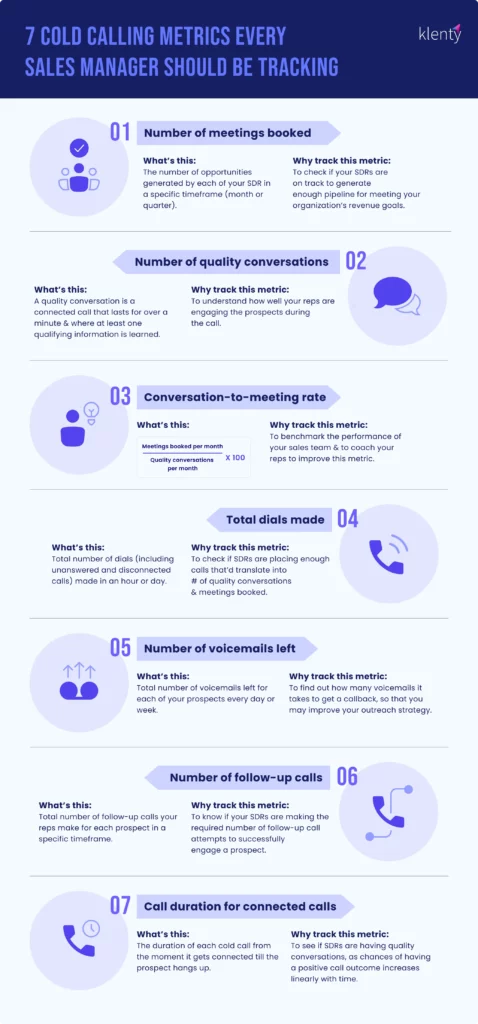You know your cold call is successful when you book a meeting. And to get there, you need to set goals for your team and help your reps meet their targets.
But, how do you know what cold calling metrics will indicate if your team is performing the activities that will help them hit their cold calling goals?
Since there’s no one-size-fits-all framework to follow, you need to track metrics that are valuable to your specific business.
To help you get started, we’ve put together 7 cold calling metrics here that’ll help your team improve their performance and book more meetings.
Before getting there, let’s first understand some basics.
What Are Cold Calling Metrics?
Cold calling metrics are data points that you can use to measure the effectiveness of the cold calling activities executed by your SDRs.
Every organization fixes an annual revenue goal each year. To hit that goal, you as the sales manager will typically fix monthly revenue goals for your sales team. This would translate to how many closed-won deals and sales opportunities you need in your sales pipeline every month.
For example, if your annual revenue goal is $1 million and your average deal size is $5,000:
- Your sales team will need to close 200 deals to meet your goal in a given year.
- To get 200 closed-won deals, you’d need 2,000 booked meetings in your pipeline (assuming 10% of the opportunities you generate end up becoming your customers)
- This means, your SDRs should book at least 167 meetings every month.
By tracking and analyzing these cold calling metrics, you can check whether each SDR on your sales team is poised to hit the target of meetings booked and pipeline generated.
In other words, tracking these cold calling metrics will give you a data-driven approach to:
- Observing individual rep activities
- Monitoring overall team progress
- Identifying areas of improvement, and
- Optimizing strategies for better results.
How To Determine Which Cold Calling Metric Is Worth Tracking?
As a sales manager, you need to determine which metrics will help you measure your cold calling success and the steps you need to take for your team to get there.
Broadly speaking, there are 2 different types of cold calling metrics that you should be tracking: Output metrics and input metrics. Let’s see each of these in detail.
- Output metrics
Output metrics help you final outcomes of your cold calling campaign that you want to achieve. Sales managers track output metrics to ensure their entire team is on the right path to meeting their goals.
The output goals you need to track to measure the success rate of your cold calling strategy are:
- Number of meetings booked
- Number of quality conversations
- Conversation-to-meeting rate
- Input metrics
These help you measure the daily or weekly sales activities that will get your team closer to meeting your monthly output metrics. In cold calling outreach, the input metrics you’ll need to track include:
- Total number of calls per day
- Number of follow-up calls
- Number of voicemails left
- Call duration for connected calls
Input metrics helps you track daily activities of your reps and give pointers as and when issues prop up, and implement necessary changes so that your team is on track to hit their output metrics.
Now, let’s dive deeper into each of these 7 cold calling metrics.
7 Cold Calling Metrics That You Should Be Tracking

1. Number of Meetings Booked
Number of meetings booked refers to the number of opportunities generated by each of your SDR in a specific timeframe (month or quarter) that gets handed over to the account executives, who will then take the deals to closure.
Why track this metric:
- At the organizational level, tracking the number of meetings booked helps you check whether your SDRs are on track to hit the target number of meetings every month or quarter, which you have arrived at based on your annual revenue goal.
- At an individual level, you can fix the target for individual reps and decide the activities required for each rep to hit their number.
Example: Based on our previous example, if you need to book at least 167 meetings every month and you have 10 SDRs in your team, you can divide the number of meetings among your sales representatives based on their previous performance and fix the individual targets.
2. Number of Quality Conversations
A quality conversation is a connected call that lasts for more than a minute and where at least one piece of qualifying information is learned. This happens when the prospect has a back-and-forth conversation with the rep.
Why track it:
Research shows successful cold calls last almost twice as long as unsuccessful cold calls. So, tracking how many quality conversations your SDR has in a given timeframe (month or quarter) helps you understand how well your reps are engaging the prospects during the call.
Example: If an SDR in your sales team has 20 meetings to book in a month, they might need to have at least 200 quality conversations every month (assuming that 10% of prospects who have quality conversations agree to hop on a meeting with you).
3. Conversation-To-Meeting Rate
The conversation-to-meeting rate refers to the ratio of the total number of meetings booked by your team to the total number of quality conversations they’ve had in the given timeframe (typically, a month).
How to calculate it: (Meetings booked per month/Quality conversations per month) x 100
Example: In a given month, if your SDRs have booked 13 meetings in total and the quality conversations your team had was 130, the conversation-to-meeting rate will be 10%.
Why track it:
The conversation-to-meeting rate helps you in benchmarking the performance of your sales team. You can compare your team’s conversation-to-meeting rate with other organizations in your industry or market and with your own past performance. Based on this, you can coach your reps to improve this metric.
4. Total Dials Made
This metric refers to the total number of dials (including unanswered and disconnected calls) made in a specific shorter timeframe, like in an hour or day.
Why track it:
By tracking the number of dials, you can check if the reps are placing enough calls that could translate into the number of quality conversations, and eventually, meetings booked.
Example: As per the example we saw earlier, an sales representative needs to book 20 meetings a month and therefore needs to have 200 quality conversations. In this case, they need to make more than 2000 cold calls in a month (as the industry average for call connect rates is 10%).
This means, each SDR should place at least 500 calls in a week, or 100 cold calls in a day.
5. Number of Voicemails Left
More than half of your cold calls will go to voicemail. Given that it can take anywhere between 20 to 50 prospecting touches to engage a cold prospect who does not know your brand, voicemail can be an important part of your cold calling success.
So, make sure to track the total number of voicemails you’ve left for each of your potential customers in a specific timeframe, as in the number of voicemails left every day/week.
Why track it:
Tracking the number of voicemails can help you find patterns in your team’s outreach activities (like how many voicemails it takes to get a callback or timings where chances of hitting voicemail is high). Based on these patterns, you can tweak your cold call outreach strategies to see better results.
6. Number of Follow-up Calls
Here’s some cold calling statistics that should give you pause: 80% of sales require 5 follow-up calls after a meeting, but 44% of sales reps give up after the first follow-up call.
So, keep track of the total number of follow-up calls your reps make for each prospect in a specific timeframe.
Example: If you’re running a sales sequence that includes multichannel touches like email and LinkedIn, then your SDRs might need to make 4-5 call attempts per prospect every week.
Why track it:
Like voicemail, follow-up calls too are crucial for prospects who don’t pick up your call the first time. Tracking this metric helps you to know if your reps are making the required number of follow-up call attempts needed to successfully engage a prospect.
7. Call Duration for Connected Calls
Finally, for the cold calls that do get connected, it’s important for you to know the call duration per prospect.
How to track it: Calculate the duration of each cold call from the moment it gets connected till the prospect hangs up.
Why track it:
We at Klenty studied how long cold calls should last and found out that the chances of having a positive outcome for cold calls increase almost linearly with time. So, this helps you know if the reps are having quality conversations with prospects, which will ultimately translate into meetings booked.
Improve Your Cold Calling Metrics With the Right Tool
According to McKinsey, a fifth of your current sales-team functions can be automated. So, to help your SDRs improve your cold calling metrics, you need the right sales automation platform.
Presenting Klenty, an end-to-end sales engagement platform that comes with a sales dialer to automate your dialing process and with conversation intelligence to help you enhance your coaching efforts.
Take a quick look at how Klenty's Sales Dialer helps you boost your cold calling metrics:
- Parallel Dialer. Skyrocket your total dials made metric with Klenty’s parallel dialer, which lets you dial up to 5 prospects at a time. Our reps were able to make over 300 calls in just one hour with Parallel Dialer.
- Local dial. Call prospects from numbers in their area code, so you can increase your chances of connecting and have more quality conversations.
- One-click voicemail. Send voicemails in a click to boost your number of voicemails left metric. Pre-record personalized voicemails, send them with just one click, and move on to make the next call.
- Goal-driven outreach. Assign daily, weekly and monthly targets for call volume and meetings booked. Also, track rep call activity volume across different timeframes.
- AI-driven summaries. Skim through any call transcripts with ease with Call IQ, Klenty’s conversation intelligence platform. For effective sales coaching, Call IQ lets you tailor your coaching for every SDR in your team with customizable summaries that focus on specific issues, such as questions asked or setting next steps.
Want to know more about how Klenty can help you track these metrics and execute your best cold calling campaign yet? Book a demo now to find out.





